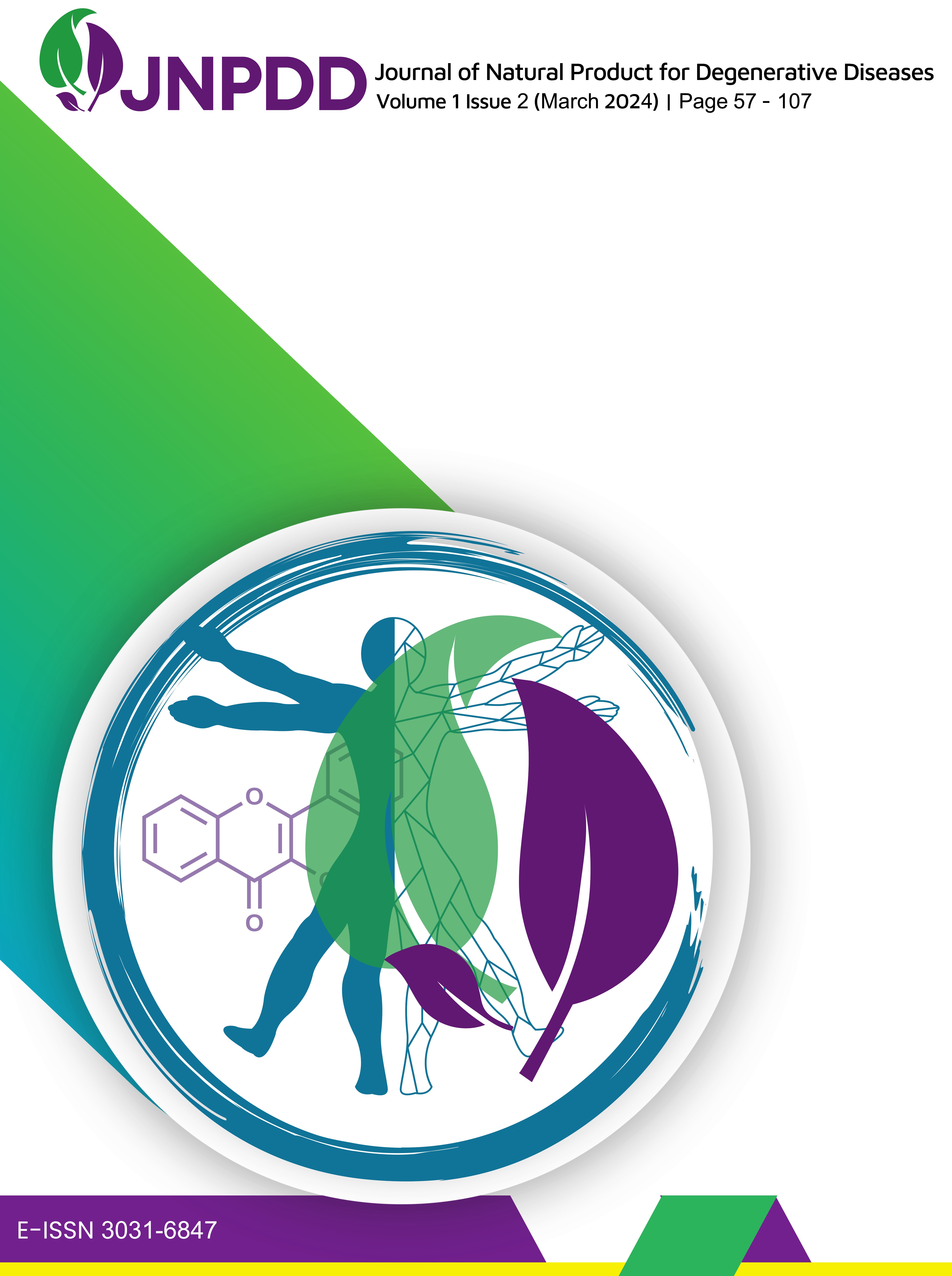Study of Potential Antiobesity Compounds from Amylchlorogenate Derivates on Leptin Hormone and their Toxicity using Molecular Docking Approach
Abstract views: 166 | PDF downloads: 123
Abstract
Chlorogenic acid, a type of phenolic acid, is a polar compound that has anti-obesity effects with unclear mechanisms. This study aims to obtain compounds that are active as antiobesity, their interaction with receptors and its toxicity. This research was carried out in several steps, internal validation of targets and methods using Yasara, docking of test compounds and positive control using PLANTs, interaction visualization using Pymol and toxicity testing using Protox-II. Validation results show four receptors and test method meet the requirements. Docking results of setmelanotide on receptor code 1PXH -113.81; 2QBP -109.163; 2QBR -110.113, 2; QBS -110.817 kcal/mol respectively. The docking results of the test compounds in 1PXH namely 7,4,5-Triamylchlorogenate (compound a) -114,333 kcal/mol. In 2QBP namely 7,3'-Diamylchlorogenate (110,152) (compound b), (compound a) (-109,818), 7,4,3',4'-Tetraamylchlorogenate (compound c) (-115,309), 7,5,3',4'-Tetraamylchlorogenate (compound d) (-112,85), 7,4,5,3',4'-Pentaamylchlorogenate (compound e) (-110,414) and 2',5'-Diamylchlorogenic acid (compound f) (-113, 565) kcal/mol. In 2QBR namely, (compound a) (-114,276), (compound e) (-111,059), and (compound f) (-110,398) kcal/mol. In 2QBS namely, (compound a) (-113.53), and (compound d) (-111,676) kcal / mol. The active site of amino acids that have affinity are, ARG45 and LYS120 in 1PXH; ASP48, SER118 and ARG47 in 2QBP; ASP48 and ARG24 in 2QBR; ASP48 and GLN262 in 2QBS code. Toxicity tests obtained oral LD50 of 5000 mg/kg BW (compounds a and f); 3800 mg/kg BW (compounds b, c, d and e). The potential compound that was active in all the test receptor codes was 7,4,5-Tripentylchlorogenate (compound a). All active test compounds were relatively safe.
References
L. P. C. Mayoral et al., “Obesity subtypes, related biomarkers & heterogeneity,” The Indian journal of medical research, vol. 151, no. 1. NLM (Medline), pp. 11–21, Jan. 01, 2020. doi: 10.4103/ijmr.IJMR_1768_17.
M. Obradovic et al., “Leptin and Obesity: Role and Clinical Implication,” Front. Endocrinol. (Lausanne)., vol. 12, no. May, pp. 1–14, 2021, doi: 10.3389/fendo.2021.585887.
R. Khera et al., “Association of pharmacological treatments for obesity withweight loss and adverse events a systematic review and meta-analysis,” JAMA - J. Am. Med. Assoc., vol. 315, no. 22, pp. 2424–2434, Jun. 2016, doi: 10.1001/jama.2016.7602.
Kiran K. Panuganti1; Minhthao Nguyen2; Ravi K. Kshirsagar3., “Obesity,” NCBI Bookshelf, 2022. [Online]. Available: https://www.ncbi.nlm.nih.gov/books/NBK459357/
K. M. Gadde, C. K. Martin, H. R. Berthoud, and S. B. Heymsfield, “Obesity: Pathophysiology and Management,” Journal of the American College of Cardiology, vol. 71, no. 1. Elsevier USA, pp. 69–84, Jan. 02, 2018. doi: 10.1016/j.jacc.2017.11.011.
E. Jéquier and L. Tappy, “Regulation of body weight in humans,” Physiol. Rev., vol. 79, no. 2, pp. 451–480, 1999, doi: 10.1152/physrev.1999.79.2.451.
D. M. Williams, A. Nawaz, and M. Evans, “Drug Therapy in Obesity: A Review of Current and Emerging Treatments,” Diabetes Ther., vol. 11, no. 6, pp. 1199–1216, 2020, doi: 10.1007/s13300-020-00816-y.
R. J. Rodgers, M. H. Tschöp, and J. P. H. Wilding, “Anti-obesity drugs: Past, present and future,” DMM Dis. Model. Mech., vol. 5, no. 5, pp. 621–626, 2012, doi: 10.1242/dmm.009621.
Havel P.J., “Role of adipose tissue in body-weight regulation: Mechanisms regulating leptin production and energy balance,” Proc. Nutr. Soc., vol. 59, no. 3, pp. 359–371, 2000, [Online]. Available: https://hdas.nice.org.uk/strategy/124016/8/EMBASE/30690383
N. Tajik, M. Tajik, I. Mack, and P. Enck, “The potential effects of chlorogenic acid, the main phenolic components in coffee, on health: a comprehensive review of the literature,” European Journal of Nutrition, vol. 56, no. 7. Dr. Dietrich Steinkopff Verlag GmbH and Co. KG, pp. 2215–2244, Oct. 01, 2017. doi: 10.1007/s00394-017-1379-1.
M. Naveed et al., “Chlorogenic acid (CGA): A pharmacological review and call for further research,” Biomedicine and Pharmacotherapy, vol. 97. Elsevier Masson SAS, pp. 67–74, Jan. 01, 2018. doi: 10.1016/j.biopha.2017.10.064.
V. Pimpley, S. Patil, K. Srinivasan, N. Desai, and P. S. Murthy, “The chemistry of chlorogenic acid from green coffee and its role in attenuation of obesity and diabetes,” Prep. Biochem. Biotechnol., vol. 50, no. 10, pp. 969–978, 2020, doi: 10.1080/10826068.2020.1786699.
J. de Ruyck, G. Brysbaert, R. Blossey, and M. F. Lensink, “Molecular docking as a popular tool in drug design, an in silico travel,” Advances and Applications in Bioinformatics and Chemistry, vol. 9, no. 1. Dove Medical Press Ltd, 2016. doi: 10.2147/AABC.S105289.
G. Madhavi Sastry, M. Adzhigirey, T. Day, R. Annabhimoju, and W. Sherman, “Protein and ligand preparation: Parameters, protocols, and influence on virtual screening enrichments,” J. Comput. Aided. Mol. Des., vol. 27, no. 3, pp. 221–234, 2013, doi: 10.1007/s10822-013-9644-8.
I. M. Almasri, “Computational approaches for the discovery of natural pancreatic lipase inhibitors as antiobesity agents,” Future Med. Chem., vol. 12, no. 8, pp. 741–757, 2020, doi: 10.4155/fmc-2019-0284.
O. Korb, T. Stützle, and T. E. Exner, “Empirical scoring functions for advanced Protein-Ligand docking with PLANTS,” J. Chem. Inf. Model., vol. 49, no. 1, pp. 84–96, 2009, doi: 10.1021/ci800298z.
D. Seeliger and B. L. De Groot, “Ligand docking and binding site analysis with PyMOL and Autodock/Vina,” J. Comput. Aided. Mol. Des., vol. 24, no. 5, pp. 417–422, 2010, doi: 10.1007/s10822-010-9352-6.
P. Banerjee, F. O. Dehnbostel, and R. Preissner, “Prediction is a balancing act: Importance of sampling methods to balance sensitivity and specificity of predictive models based on imbalanced chemical data sets,” Front. Chem., vol. 6, no. AUG, Aug. 2018, doi: 10.3389/fchem.2018.00362.
A. K. Schrey et al., “Computational prediction of immune cell cytotoxicity,” Food Chem. Toxicol., vol. 107, pp. 150–166, Sep. 2017, doi: 10.1016/j.fct.2017.05.041.
B. Carpenter et al., “Structure of the human obesity receptor leptin-binding domain reveals the mechanism of leptin antagonism by a monoclonal antibody,” Structure, vol. 20, no. 3, pp. 487–497, 2012, doi: 10.1016/j.str.2012.01.019.
E. W. Bell and Y. Zhang, “DockRMSD: An open-source tool for atom mapping and RMSD calculation of symmetric molecules through graph isomorphism,” J. Cheminform., vol. 11, no. 1, 2019, doi: 10.1186/s13321-019-0362-7.
J. P. F. Bai and D. R. Abernethy, “Systems pharmacology to predict drug toxicity: Integration across levels of biological organization,” Annual Review of Pharmacology and Toxicology, vol. 53. pp. 451–473, Jan. 2013. doi: 10.1146/annurev-pharmtox-011112-140248.




